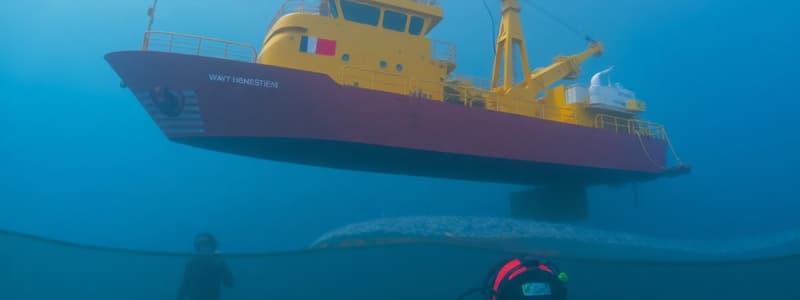Podcast
Questions and Answers
What primary factor contributed to the crane hook striking the diver's helmet during the subsea spool tie-in operations?
What primary factor contributed to the crane hook striking the diver's helmet during the subsea spool tie-in operations?
- The diver's failure to maintain a safe distance from the pipe handling frame (PHF).
- Inadequate communication between the crane operator and the dive supervisor regarding the hook's position. (correct)
- The use of incorrect rigging for disconnecting the PHF from the crane.
- The unexpected failure of the diver's helmet to withstand the impact.
Why did the crane operator mistakenly believe the crane hook had reached the seabed?
Why did the crane operator mistakenly believe the crane hook had reached the seabed?
- The pipe handling frame (PHF) was emitting a signal confirming the hook's position.
- The crane wire indicated slack, suggesting the hook was resting on something. (correct)
- The crane's monitoring system failed to provide accurate depth readings.
- The diving supervisor visually confirmed the hook's position on the seabed.
Which of the following actions would be MOST effective in preventing a recurrence of the incident?
Which of the following actions would be MOST effective in preventing a recurrence of the incident?
- Implementing stricter helmet inspection protocols to ensure maximum impact resistance.
- Using additional locating beacons, underwater cameras, or sonar to better track equipment position. (correct)
- Requiring all divers to undergo additional training in underwater collision avoidance techniques.
- Limiting subsea operations to daylight hours to improve visibility.
What immediate action taken after the incident demonstrated effective safety practices?
What immediate action taken after the incident demonstrated effective safety practices?
Besides communication protocols, what other procedural adjustment would MOST directly address the root cause of the incident?
Besides communication protocols, what other procedural adjustment would MOST directly address the root cause of the incident?
Flashcards
Subsea Crane Hook Incident
Subsea Crane Hook Incident
During subsea spool tie-in, a crane hook struck a diver's helmet due to miscommunication, inadequate crane pennant length and poor visibility.
Enhanced Visibility Aids
Enhanced Visibility Aids
Using alternative methods like additional locating beacons, underwater cameras, or sonar to track critical equipment in poor visibility.
Reinforced Communication
Reinforced Communication
Clear communication and confirmation between the dive supervisor, crane operator, and divers to ensure everyone is aware of the equipment's location.
Adequate Crane Pennant Length
Adequate Crane Pennant Length
Signup and view all the flashcards
Pre-Operation Inspections
Pre-Operation Inspections
Signup and view all the flashcards
Study Notes
- During subsea spool tie-in operations, a crane hook unexpectedly struck a diver's helmet
- Published on 6th March 2025
What Happened
- Divers were working on the seabed in poor visibility during subsea spool tie-in operations
- The Diving Supervisor instructed the crane operator to lower the crane hook to the seabed after landing the pipe handling frame (PHF)
- The diver was to disconnect rigging from the crane
- The crane operator reported 'no weight' on the crane wire, leading the Diving Supervisor to assume the hook had reached the seabed
- The diver was instructed to proceed with disconnecting the PHF from the crane
- The crane hook unexpectedly struck the diver's helmet while positioned beneath the PHF and moving to disconnect the rigging
- The diver reported they were unharmed and returned to the dive bell
- The dive was aborted
- The diver's reclaim helmet was damaged beyond repair, including the side block, but the integrity of the helmet was maintained
- The diver was unharmed
What Went Right
- Diver 2 promptly assisted Diver 1, ensuring no injuries occurred
- Both divers immediately returned to the bell safely
- Both divers and the crane block had locating beacons fixed to them, enabling accurate tracking
- All procedures, lifting plans, and Job Hazard Analysis (JHA's) were followed throughout the operation
- The diver remained uninjured because the protective equipment absorbed the impact
What Went Wrong
- The crane hook came to rest on the top beam of the PHF when lowered for PHF rigging disconnection
- A 'no weight' reading resulted, leading the crane operator to assume the hook had reached the seabed
- The hook slipped off the beam and struck the side of the diver's helmet as the diver approached the disconnection point
What Was The Cause
- Inadequate length of crane pennant/stinger, which did not provide sufficient distance between the divers and the crane hook
- Poor visibility, hindering the ability to accurately observe the crane hook's position
Lessons and Actions
- Ensure adequate distance between divers and crane hook
- The length of the crane pennant/stinger should maintain a safe distance between the divers and the crane hook during subsea operations, particularly in limited visibility conditions
- Enhanced visibility aids and monitoring
- Use alternative methods in environments with poor visibility, such as additional locating beacons, underwater cameras, or sonar to better track equipment like the crane hook
- Improved monitoring can prevent misjudgments regarding equipment location
- Reinforce communications, challenge assumptions
- Minimize assumptions regarding equipment position
- Reinforce clear communication and confirmation procedures between the dive supervisor, crane operator, and divers to ensure all parties are fully aware of the equipment's location
Additional Member Actions
- Updated project procedures to specify minimum pennant lengths for different operations
- Conduct pre-operation inspections of all rigging and lifting equipment, including crane hooks and pennants, to ensure they meet safety standards
- Updated the Job Hazard Analysis (JHA) to incorporate lessons learned regarding safe distances, visibility, and communication requirements for subsea lifting operations
Studying That Suits You
Use AI to generate personalized quizzes and flashcards to suit your learning preferences.




